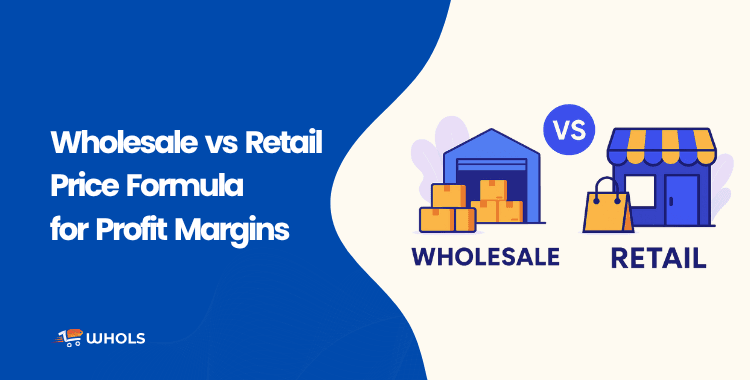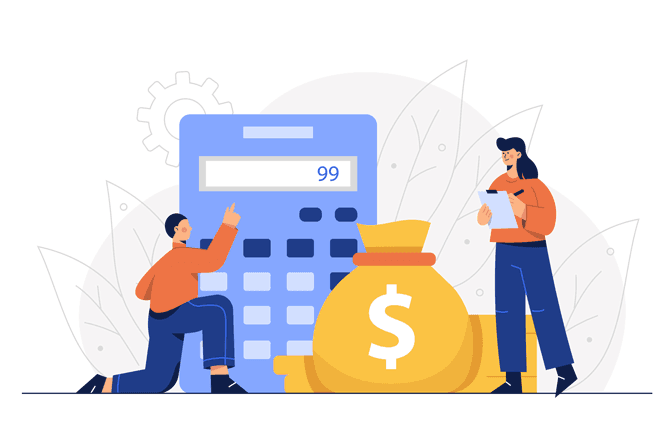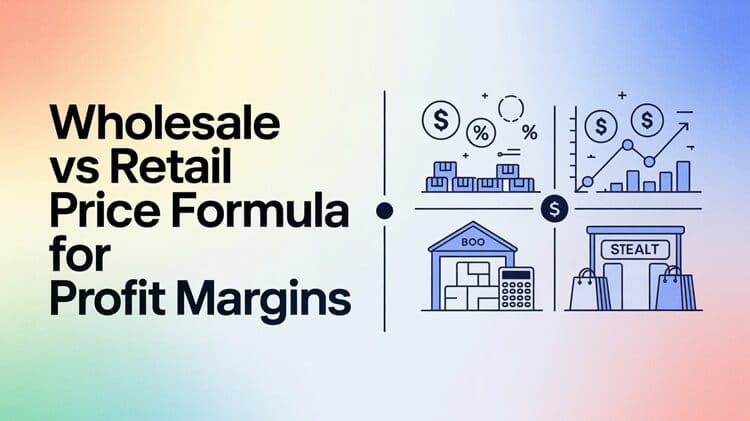
Understanding how to calculate profit margins is very important for every business owner. Mastering the difference between wholesale and retail pricing formulas helps you price sensibly and maximize profitability.
Whether you’re a manufacturer setting wholesale prices or a retailer determining consumer costs, this guide provides the exact formulas and strategies you need. We’ll cover everything from basic calculations to advanced pricing psychology that drives sales.
Wholesale prices are for bulk consumers, whereas retail prices are for end consumers. Both modes of pricing have their own formula for calculating profit margins. Correct pricing increases profits and attracts more consumers to your store.
Most new sellers will guess their prices without using any calculation. That could lead to lost profits or reduced sales.
As per research, 34% of startup failures are due to poor product-market fit, including pricing that doesn’t align with customer expectations. Knowing various price calculation methods gives you better control over your business finances.
In this article, we’ll discuss the wholesale vs retail price formula and offer advice on how to improve the price of your products today. So why wait? Explore our pricing calculator today and boost your business with smarter pricing!
Key Takeaways
- Calculate the wholesale price using the cost plus the desired profit percentage
- Retail prices must cover operational costs and profit margins
- Price differentiation is essential between wholesale and retail customers
- Market demand directly influences optimal pricing strategy decisions
- Competition analysis prevents underpricing or overpricing products
What is Wholesale Pricing?

Wholesale price is the cost of products bought in bulk. It’s the price companies pay when purchasing products from suppliers or manufacturers. In 2024, Asia-Pacific led the wholesale market. The market has experienced significant growth in recent years.
From 2025 onwards, it is expected to grow at a 7.3% CAGR. Wholesale prices tend to be lower than retail prices. This is due to the fact that the buyer is buying in bulk.
Retailers mark up the wholesale price to sell at a higher price to consumers. Wholesale pricing saves the company on cost and increases profit margins. Wholesale discount rates typically range from 30% to 50% off the retail price.
It is usually used by resellers, distributors, and retailers. Being aware of wholesale prices is essential in having a successful business. Companies can price products competitively by purchasing at wholesale prices.

What is Retail Pricing?

Retail pricing is the final price customers pay for a product. Unlike manufacturer and distributor prices, the retailer determines the retail price. It is calculated based on market competition, demand, and supply.
Retailers set prices to receive maximum profit, along with offering value to the consumer. They aim to have an equilibrium between profitability as well as willingness to pay among customers.
The retail markup formula is the overhead cost added to the desired percentage profit. A retail price might be suggested by manufacturers to instruct the retailer. The key is to set a price that aligns with business goals and meets consumer expectations effectively.
Many retailers use keystone pricing (2x wholesale cost) as a starting point, then adjust based on market conditions.
Key Differences Between Wholesale and Retail Pricing
Here’s the list of key differences between wholesale and retail pricing:
| Wholesale Pricing | Retail Pricing |
| The price retailers pay to buy goods in large quantities | Final price paid by customers for individual products |
| Sold to businesses or resellers | Sold directly to end consumers |
| High volume, low margin per unit | Lower volume, higher margin per unit |
| Smaller margins with bulk selling | Higher margins to cover added costs |
| Fewer overhead costs and simpler logistics | Includes marketing, rent, salaries, and utilities |
How to Use Our Pricing Calculator(Wholesale vs Retail Price Formula)
Our free pricing calculator simplifies the complex process of determining your wholesale and retail prices. Simply input your cost price, desired wholesale markup percentage, and retail markup percentage. The calculator instantly shows your profit margins, suggested prices, and break-even points. You can also compare different scenarios to find the optimal pricing strategy for your business.
Wholesale Pricing Formula
The wholesale price formula helps determine product pricing for businesses. It considers cost price and the desired profit margin. Use this formula:
Wholesale Price = Cost Price + (Cost Price × Wholesale Markup %)
Suppose your Cost Price is $10 and you want a Wholesale Markup of 30%:
Wholesale Price = $10 + ($10 × 0.30) = $13
Try Now,
Wholesale Price Calculator
Retail price formula:
Retail Price = Wholesale Price + (Wholesale Price × Retail Markup Percentage)
For example, if your wholesale price is $50 and you want a markup of 40%:
Retail Price = $50 + ($50 × 0.40) = $50 + $20 = $70
Retail Price Calculator
Factors for Determining Wholesale Price vs. Retail Price
When setting wholesale and retail prices, several key factors must be considered:
- Cost of Goods Sold (COGS): This includes all direct costs tied to producing or purchasing the product. Accurately calculating COGS ensures you set prices that cover your costs and allow for profit.
- Market Demand: Assess the demand for your product in the market. Set prices that attract buyers while maintaining profitability.
- Operating Costs: Include overhead costs like rent, utilities, marketing, and employee salaries. These must be factored into pricing decisions.
- Profit Margin: Determine how much profit you aim to earn from each product sold. Use this figure to calculate the final price.
- Competition: Research competitors’ prices in the market. This helps you stay competitive while meeting industry standards.
- Seasonal Considerations: Factor in seasonal demand fluctuations that may require pricing adjustments throughout the year.
- Psychological Pricing: Consider pricing strategies like charm pricing ($9.99 vs $10) that influence consumer perception.
When to Use Wholesale vs Retail Pricing Models
Understanding when to apply each pricing model is crucial for business success:
Use Wholesale Pricing When:
- Selling to other businesses (B2B)
- Moving large volumes of inventory
- Working with distributors or resellers
- Building long-term business relationships
Use Retail Pricing When:
- Selling directly to consumers (B2C)
- Operating a storefront or e-commerce site
- Focusing on individual customer experience
- Building a brand reputation
5 Proven Strategies to Maximize Your Profit Margins
Setting the right price helps you grow and stay profitable. Follow these simple tips to make smarter pricing decisions and boost your profit margins.
- Use Different Prices for Retail and Wholesale: Retail and wholesale customers need different pricing approaches. Create one price for direct buyers and one for bulk buyers. This keeps your profit steady no matter who is buying.
- Consider the Order Volume Before Pricing: Think about how many units your customers usually buy. Offer better prices to those who order more. This encourages larger purchases and builds long-term relationships.
- Check Your Prices Every Few Months: Wholesale prices should not stay the same forever. Review your pricing strategy every few months. This helps you match market trends and stay profitable.
- Study Competitor Pricing Before You Decide: Check how other businesses price similar products. It helps you remain competitive. Use this insight to adjust your pricing and stand out in the market.
- Keep Your Profit Margin Clear and Consistent: Decide your target profit margin before finalizing the price. Keep it consistent across products. This builds a solid and predictable revenue model.
Industry-Specific Markup Guidelines
Different industries have established markup standards based on market dynamics:
- Clothing/Apparel: 50-80% retail markup
- Electronics: 30-50% retail markup
- Food/Grocery: 15-35% retail markup
- Jewelry: 100-200% retail markup
- Furniture: 80-150% retail markup
- Beauty Products: 60-80% retail markup
Real-World Examples: Wholesale vs Retail Pricing in Action
Example 1: Clothing Boutique: A boutique purchases designer t-shirts at a wholesale price of $15 each. Using a 70% retail markup: Retail Price = $15 + ($15 × 0.70) = $25.50
Example 2: Electronics Store: An electronics retailer buys smartphones for $200 wholesale. With a 40% markup: Retail Price = $200 + ($200 × 0.40) = $280
Example 3: Grocery Store: A grocery store purchases organic honey at $4 per jar wholesale. Using a 25% markup: Retail Price = $4 + ($4 × 0.25) = $5
5 Critical Pricing Mistakes That Kill Profit Margins
Here are 5 critical pricing mistakes to look at:
- Underestimating Costs: Don’t forget to include all expenses in your price calculation. This includes hidden costs like payment processing fees, returns, and seasonal storage.
- Ignoring Market Dynamics: Be aware of market trends and consumer behavior when setting prices. Use tools like Google Trends and industry reports to stay informed.
- Misjudging Consumer Willingness to Pay: Setting prices too high or low can negatively impact sales and margins. Conduct market research or A/B testing to find the sweet spot.
- Failing to Adjust Prices Regularly: Regularly review and update prices based on changes in costs or demand. Set calendar reminders for quarterly pricing reviews.
- Overlooking Profitability and Competitiveness: Ensure prices cover all costs and remain competitive in the market. Use competitive analysis tools to track competitor pricing changes.
Frequently Asked Questions
Are there multiple retail price formulas or strategies for different types of products or industries?
Yes, retail price formulas may vary with the nature of the product and industry. For example, high-end products can have greater markup percentages, while day-to-day products have competitive pricing strategies to attract buyers. Luxury goods often use prestige pricing, while commodities rely on competitive pricing.
Why is a pricing formula important for business success?
A pricing formula helps businesses ensure profitable margins. It ensures product costs, including overheads, are covered and provides a clear path to pricing for both wholesale and retail customers. Studies show businesses using formal pricing strategies are 40% more likely to achieve their profit goals.
How does a dual pricing strategy work in wholesale and retail?
A dual pricing strategy charges different wholesale and retail prices. It ensures that both B2B consumers and B2C consumers are priced according to what is appropriate for them, keeping your revenue stable while addressing unique markets.
What are the errors I should not make when applying the price formula?
Do not underestimate costs, overlook overheads, and neglect to revise prices from time to time. Also, pay attention to market trends so that your pricing is competitive and profitable. Additionally, avoid emotional pricing decisions; always use data to guide your strategy.
How frequently should I check my pricing formula?
Check your pricing formula from time to time to revise for fluctuating costs, market trends, and consumer demand. This keeps your prices competitive and profitable in the long run. Best practice: conduct a thorough review quarterly and monitor key metrics monthly.
Conclusion
Getting your pricing right can make or break your business success today. Understanding the wholesale vs retail price formula helps you set prices that truly work. Use simple formulas to calculate profits that support business growth.
The right pricing strategy keeps customers happy and your profits strong. Avoid guesswork and review prices often to stay ahead of market changes.
Ready to make more confident pricing decisions? Start applying these formulas now and take control of your profit margins.
Try our free pricing calculator to instantly see your profit margins and optimize your pricing strategy.

